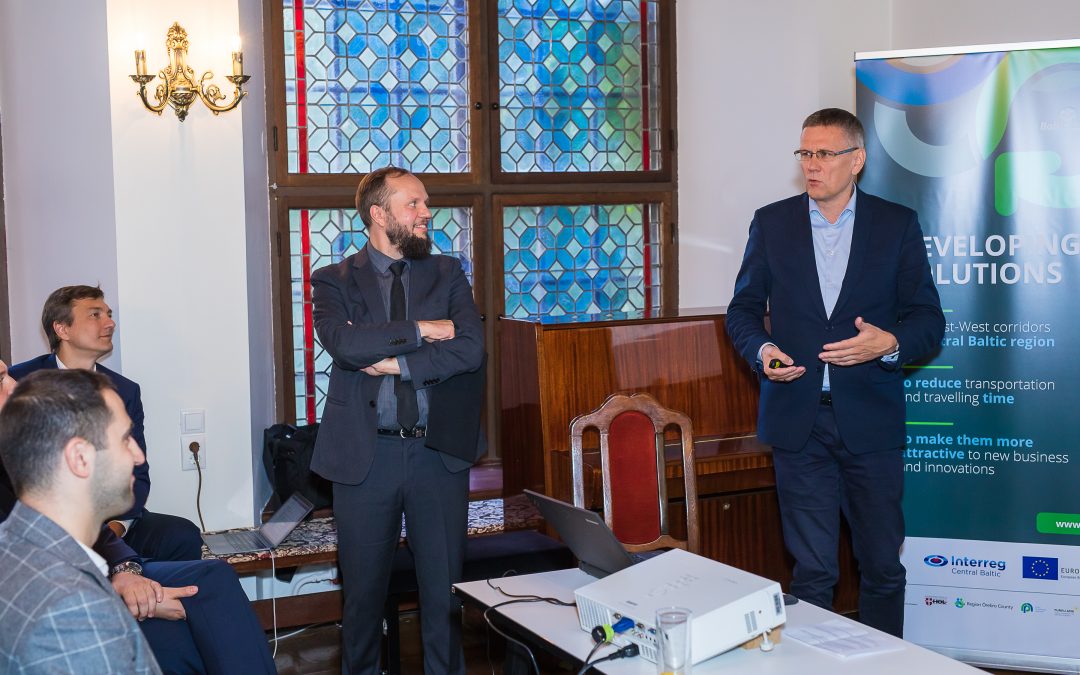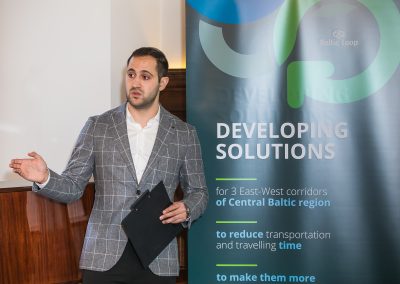Baltic Sea is connecting Estonia, Finland, Latvia and Sweden into wide network of intertwined connections. We are physically around worlds most vulnerable sea basin and we are so related, that this little sea (0,45 % of the world oceans) is enjoying 10% of world sea-traffic. This puts us into difficult situation as logistics and transport are globally growing and prosperity is in direct connection with the intensity of trade. We all want to enjoy both strong economy and clean environment. The only option is to make transport chains and logistics more effective and sustainable.
Baltic Loop highlights important issues in the transport sector
Interreg Central Baltic Programme 2014-2020 project Baltic Loop is analysing the situation in the heart of Baltic Sea by investigating 3 corridors crossing the sea from east to west in Central Baltic Sea. The first task is to understand and identify bottlenecks and recognize potential for trade and logistics. At the same time the project is looking for ways to innovate our business models and see what is there in regards to digitalization and technology.
On 24th and 25th of September Baltic Loop project had Kick-Off Event in Tallinn. The discussions on two panels were only scratching the surface of the ambitious task. Policy makers panel was discussing the role of the public authority for transport and logistics.
According to Inna Nosach from Estonian Ministry of Economic Affairs and Communications, we are in the midst of changing environment and need to respond to new challenges. The ministry is preparing Transport and Mobility Master Plan 2021+. The plan is setting targets to create all accessible (8-80 year old principle), attractive, competitive, healthy and safe mobility and transport environment.
In the words of Association of Local Authorities Ida-Viru County development expert Hardi Murula, the transport flows in eastern border of Estonia have declined from heydays and all initiatives to smoothen the transport flows, to invite tourism and investments into infrastructure are welcomed with open arms.
Tõnis Hintsov, representing Estonian Supply Chain Association ProLog is spearheading the Single Window Initiative, an effort to digitalize the transport. In essence it is a noble task of taking our activities in chains of logistics into 21st century, meaning paperwork, tax, customs etc. and digitalizing the flow of information so that transport operators can concentrate on their main task instead of paperwork.
Discussions over digitalization were rather heated and currently we are dealing with the situation initiatives and all solutions in the market are trying to establish their platform as dominant where information is not so easy to acquire even for the noble cause. While technologically it is rather simple process, then exchange between companies, state and other relevant partners needs deeper trust. Additionally, we have several similar initiatives and all solutions in the market are trying to establish their platform as dominant.
Climate goals are going to shape the future of transport. This is one of the things that both panels were agreeing. The Baltic Sea has some initiatives like Sulphur Directive. It has forced the industry to make heavy investments as explained by DFDS Eesti managing director Peeter Ojasaar. While private sector understands the need for sustainable policies, then practice that offers predictability of new requirements and offers solutions would be appreciated. Logistics operators noted that clients are looking for the best price/timesaving ration in logistics, so paying extra for greener transport is not efficient policy. Environmental responsibility is appreciated and there are few clients that are asking for certificates, but in order to make sustainable policies to work, there has to be business advantage. Margus Sitsi, Business Manager in Port of Tallinn mentioned that their policy is to offer some discount on port fees for environmentally conscious companies as one simple example.
Port of Tallinn has made some significant investments in Smart Port solutions. Impact of smart queuing systems and just in time arrival for the trucks offer, especially to the ports in the centre of the city like Tallinn Old Harbour, a chance to free land needed for port operations, keep trucks waiting behind city borders and lessen the number of people needed for organizing loading and unloading. These developed Smart Port solutions are going to be adapted by ports of Stockholm and Helsinki.
Dynamics in the Baltic Sea trade are not as balanced as shipping companies would like, the number of Estonian export by the sea to Sweden is much larger than Swedish import to Estonia and only 5-10% of the total passengers to Estonia are coming from Sweden as explained by Peeter Ojasaar from experience of DFDS ferry operations between Paldiski – Kapellskar. The business model of trucking companies isn’t helping as well.
Inna Nosach stressed the importance of shift to rail as a policy and the whole region is hoping to a positive structural change in the logistics when Rail Baltic arrives. Aivar Jaeski, Country Manager of RB Rail AS for Estonia and Finland, is convinced that estimated annual load by 2030 on Rail Baltic of 5 million passengers and 16 tons of cargo are heavily underestimated and with sound business models can be exceeded significantly. And some of the main feeder lines for Rail Baltic in our region are these east-west corridors highlighted by project Baltic Loop. Urmas Peterson from Operail AS, said that it is going well for the railway logistics company, that used to be part of Eesti Raudtee, a state-owned railway and infrastructure company. Initiatives like Tartu-Sillamäe-Tartu container line, that are taking freight from trucks to railway, so there is a possibility. However, the real bottlenecks in railway are due to regulations and rules that can be even more severe obstacles than underdeveloped or outdated infrastructure in some cases.
In real life we are in a situation where road transport is growing faster that railway. Railway is far off from days when mainly oil and oil products from Russia were rolling through Estonian Ports. Since 2007 the decline of transit in Estonia has been heavy and both ports and railway have had to look for other markets and freight segments. The reasons of change in trade is partly due to Russian investments into ports like Ust-Luga, but mainly the reasons are political. Participating panellists expressed hope that pragmatic relations with our eastern neighbour could be possible. It is a hope with a slight chance of success since on the administrative level the discussions are reinstalled.
Paldiski – a hub for transport and industry
The second part of the Kick-off meeting was a visit to one of the busiest ports and industry hubs in Estonia, Paldiski. It is a small town with a very interesting and challenging history. Founded by Russian czar Peter I in 1715 and later, during soviet era, it was a closed city and a Soviet Navy nuclear submarine training centre. It has been a tough challenge to bring the city up from ashes after the Soviet Army left Paldiski in 1994. The impact is still visible in the city. Asso Nettan’s presentation about the Lääne-Harju Municipality goals showed also that some problems were still there and latest Estonian administrative reform to unify 4 municipalities, including City of Paldiski, into Lääne-Harju Municipality was not very smooth.
However, the history has made it possible to really invite industry into the city and as one of best natural ports in the Baltic Sea. The town has connections by both road and rail. Paldiski has become strong industrial town and two ports are attractive for logistics. Last large investment of near 1 billion euro in methanol plant has been decided and there is still great potential to attract further investments that serve both growth and carbon neutrality as explained by Peep Siitam, representative of Team Paldiski.
The day ended with a tour to Paldiski South Port operated by Port of Tallinn. Hopefully persons participating in this visit got better understanding of port operations and can appreciate the significance of modal hubs for logistics.
All Baltic Loop project partners are looking forward to finding common solutions to problems raised during kick off meeting and to continuing dialog with stakeholders in the area.



